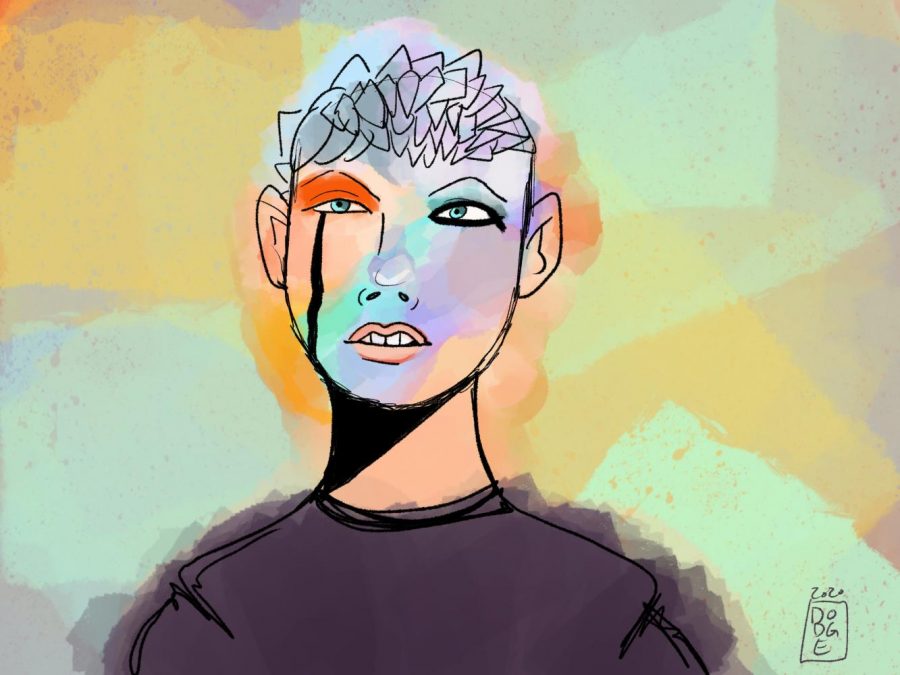A version of this article appeared in the Monday, April 13, 2020 e-print edition. Email Mandie Montes at [email protected].
After coming out as nonbinary in 2018, Gallatin sophomore Milenka Bermanova realized that some of their talents such as applying expressive makeup on themselves and designing chainmail headpieces are skills that would be useful as a drag performer.
It wasn’t until they started attending drag shows and seeing live performances that Bermanova knew they wanted to be part of the drag community. Not long after, they met their drag mother and performed for audiences in Brooklyn. They will soon celebrate their one-year of being a drag performer, coming up on April 18.
While they have a range of performances, Bermanova’s signature performance tells the story of their resistance and acceptance of the autoimmune disease they live with, alopecia, which caused them to lose their hair at 11 years old and set a lot of personal changes and challenges into motion. They perform to a compilation of songs from an episode of “Adventure Time” and lip-sync, imitating speaking to a wig, their “crown.” In reality, wigs were a way to hide the effects of their autoimmune disease from people, but now, rather than relying on using wigs, Bermanova embraces the way they look. They either wear chainmail headpieces they make or nothing at all on their head.
Mixing fantastical story lines with their real life experiences has helped them with thoroughly processing what they’ve been through. For Bermanova, performing is not just about “getting better at applying makeup or designing props,” but rather to be present in the moment with an audience and genuinely connect with others by sharing their life story.
Listen to the audio profile.
You can find a transcript of the audio profile below.
[TRANSCRIPT]
Milenka Bermanova, Gallatin sophomore
I always liked doing different expressive makeup things on myself and like I was always into like um like making like garments and accessories. So, I guess I had like the skill set to physically do drag and like I would’ve hypothetically like done it just for myself but like I didn’t think I could like actually do it as a thing.
As I was getting into drag, I was doing like a project about like what drag is. So, the way that like multiple people who I interviewed put it is that, “[drag] is the art form of yourself and it’s like the art form of like the most genuine self-expression” and like this is something that my drag mother said that like “[drag] doesn’t really have to anything with gender.”
Like the more shows that I saw, the more I was thinking like, “Hmm. Maybe I could do this,” because I was seeing more like non-binary and like gender-nonconforming performers.
In this one performance, I have like a wig that I perform with. So, I like start out the performance like in my chainmail and then, like, I find a wig and like, it’s sort of like a, like a flashback representation.
[CLIPS FROM BERMANOVA OF THEIR SIGNATURE DRAG PERFORMANCE.]
And that sort of goes into like my, my history with alopecia which is an autoimmune disease. So, like I don’t, um, or like my, my hair fell out when I was 11, um, and so, like, I feel like that’s been like a very formative experience.
[SAME CLIP FROM BERMANOVA OF THEIR SIGNATURE DRAG PERFORMANCE.]
Just looking at like my first performance that I did a year ago and then a performance that I did like just last week, I’m really excited because I feel like I’ve seen like internal growth through my drag. Like it’s not even about like me getting better at makeup or me getting better at performing. I think I just become better, or like, I, I’ve, I see the progress that I made in like understanding myself and like, um, the progress I made in like my relationships to what, I guess like the stories that like have made me who I am.
[SAME CLIP FROM BERMANOVA OF THEIR SIGNATURE DRAG PERFORMANCE.]
My name is Milenka. I am a sophomore in Gallatin. I study art as community empowerment with a focus on drag and night life and sort of looking into expanding to art institutions and queering and decolonizing art institutions and I’m also minoring in American Sign Language.


























































































































































